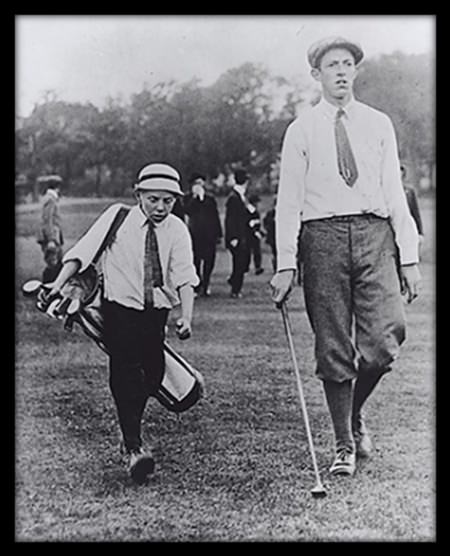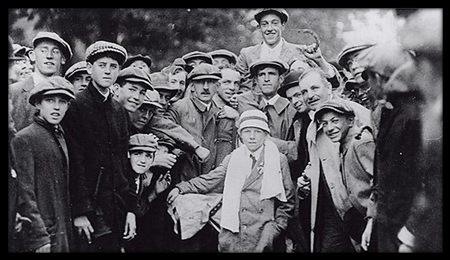It is appropriate the last column for 2013 be dedicated to an event that occurred precisely 100 years ago; an event that many regard as primarily responsible for golf making it into the mainstream of US sport.
The scene was the 1913 US Open held at The Country Club in Brookline, Massachusetts. Back then US golf was still in its infancy. It was a time when amateur golf was the domain of the wealthy (think Gatsby), and professional golf existed primarily to provide some sort of income for former caddies. Back then the USGA ruled that caddies caddying after the age of 16 lost their amateur status. Society looked down on professional golfers.
 Ouimet and Lowery – 30 years between them.
Ouimet and Lowery – 30 years between them.
Great Britain ruled the waves and almost everything else. Since the first US Open, held in 1895, British golfers (16 wins) had dominated. These were professionals at the height of their game, and although top amateurs were respected, they rarely featured.
Against this backdrop should be added a certain social nuance; that US society was still regarded, on both sides of the Atlantic, as somewhat less sophisticated than the upper echelons of Empire. Indeed, it was a time when the British Empire reigned over everything, including golf.
But no one told 20-year-old amateur, Francis Ouimet, and his 10-year-old caddie, Eddie Lowery. Ouimet’s father, who worked as a gardener at the Brookline Country Club, had bought a house adjacent to the 17th hole. They moved in when Francis was four years old. He started caddying at the Country Club from age 11, and using borrowed clubs and balls he found around the course, taught himself how to play.
Earlier in 1913, Francis Ouimet had won the Massachusetts Amateur. This along with his performance in the US Amateur (quarter-finalist), and his undoubted knowledge of the host course saw the USGA invite him to compete in the US Open.
 The famed photo of Francis Ouimet (top) and caddie Eddie Lowery (centre) post victory.
The famed photo of Francis Ouimet (top) and caddie Eddie Lowery (centre) post victory.
This showcase of US Golf had been postponed from its original June date to allow for the participation of champion golfer Harry Vardon (Vardon grip, Vardon Trophy), and Ted Ray, the 1912 Open Champion, who were touring the US playing exhibition matches.
Whilst it was Ouimet’s first appearance in the championship, he knew the course better than most. Notwithstanding, the world-renown Vardon and Ray were the clear favourites, and they along with nearly everyone else were favoured over Ouimet.
On the day before the championship started, Eddie Lowery and his older brother wagged school, but only Eddie managed to avoid the truant officer. He then convinced Ouimet to hand him his bag.
After 36 holes, Vardon was in a tie for the lead. Ray was two back followed by Ouimet who was four off the pace. At the end of the third round they shared the lead, a position repeated 18 holes later when all three posted a score of 304. By this stage, interest in the event had grown beyond anything US golf had witnessed. The stage was set for a dramatic playoff the following day.
The media made the most of it with David vs Goliath – both of them – stories aplenty. This kid and the squirt carrying his bag, both from the wrong side of the tracks, had no right being in the same contest against such revered opposition. Furthermore, not only was he an amateur, but he was US-born. Underdog, amateur, and one of us, with a chance of putting the British Empire in its place – it didn’t come much bigger.
Before the playoff, a member of the Country Club offered a reasonable sum to the cash-strapped Ouimet if he agreed to take a more experienced caddie into the playoff. Ouimet declined the offer.
The 18-hole playoff saw Ouimet prevail by five over Vardon and six over Ray. Crowds the like of which US golf had never seen hailed their new champion. The media greeted the victory as a coming of age for US society, as well as US golf.
In the years immediately following Ouimet’s US Open triumph, golf in the US took off with player numbers increasing by a staggering two-million over the next decade.
Ouimet went on to win the US Amateur twice (1914 and 1931). He played on the first eight Walker Cup teams and was captain of the next four. His playing record in these trans-Atlantic matches was an outstanding 11-1. In 1951 he became the first non-Briton elected Captain of the R & A. He was inducted into the World Golf Hall of Fame in 1974, seven years after his death in 1967.
Had the 20yo amateur and his 10yo caddie not prevailed that day, golf may not have gone mainstream… and Thailand wouldn’t have courses or caddies.
Thank you Francis. Thank you Eddie.
Happy New Year!
Golfnutter




